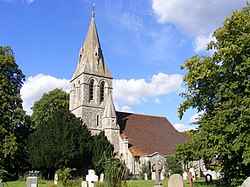Wraysbury
| Wraysbury | |
| Buckinghamshire | |
|---|---|
 Parish church of St Andrew | |
| Location | |
| Grid reference: | TQ005745 |
| Location: | 51°27’29"N, 0°33’7"E |
| Data | |
| Population: | 3,641 (2001) |
| Post town: | Staines-upon-Thames |
| Postcode: | TW19 |
| Local Government | |
| Council: | Windsor and Maidenhead |
| Parliamentary constituency: |
Windsor |
Wraysbury is a village and civil parish in the far south of Buckinghamshire close to the borders of Berkshire, Surrey and Middlesex. Wraysbury is 18 miles west by south-west of London.
History
Investigation by Windsor and Wraysbury Archaeological Society of a field in the centre of Wraysbury to the east of St Andrew's church revealed evidence of human activity in Neolithic times. Many hundreds of flint artefacts were found and are now in the care of the Windsor Museum collection.
The village name is traditionally spelt traditionally spelt Wyrardisbury, is Anglo-Saxon in origin and means 'Wïgrǣd's fort'. Its name is recorded in the Domesday Book of 1086 as Wirecesberie[1] and Wiredesbur in 1195. There is a pub across the river in Old Windsor, called the Bells of Ouseley and it has been suggested that this is another archaic spelling of Wraysbury. However a more likely explanation is that it is named after the bells of Osney Abbey which were brought downstream at the dissolution and disappeared into the mud at this point.
The village was a portion of hunting grounds when the Saxons resided at Old Windsor. New Windsor was built in 1110 by King Henry I and he moved in, in 1163. The lands around Wraysbury were held by a number of noblemen.
Magna Carta Island and Ankerwycke
Magna Carta Island, in the parish of Wraysbury, was the location of the sealing of the Magna Carta in 1215.
On the Ankerwycke estate in the village are the ruins of a Benedictine nunnery, founded in the reign of King Henry II. One of the 50 oldest trees in the United Kingdom can be found in Wraysbury. At around 2,000 years old,[2] the Ankerwycke Yew dates from the Iron Age, and is so wide that you can fit a Mini Cooper behind its trunk and not see it from the other side. Local legend says that Anne Boleyn once sat under the tree, while residing at the Ankerwycke Estate, but this still has to be verified.[3] The Ankerwycke estate was bought by John Blagrove a prominent Jamaican slave owner, who did much to improve the estate.[4]
Coming of the Railway
The village saw major change in 1848 with the arrival of the railway which opened up employment opportunities and afforded the chance to travel easily and quickly to and from the village. In the History of Wraysbury published in 1862, G.W.J. Gyll extolled the benefits to the village:
| “ | Railways have much improved the locality and the condition of the people also, and it is a powerful solvent to diminish provincial rusticity, local and self-importance; class prejudice and all the elements of isolation melt away in its presence. The railway through our parish has been of great use to it; has enhanced the value of property, as is the case wherever such a project has been executed, despite the fears of those who repressed the enterprise. | ” |
William Thomas Buckland was the local surveyor and valuer employed to handle the compensation claims resulting from the purchases of land for the new railway.[5] This business of Buckland & Sons grew into an estate agency, which had an office in Windsor High Street for the following 150 years.[6]
References
- ↑ The National Archives documents online website, Crown copyright material is reproduced with the permission of the Controller Office of Public Sector Information (OPSI)
- ↑ The Heritage Trees of Britain and Northern Ireland by Jon Stokes and Donald Roger: The Tree Council [ISBN 1-84119-959-1]
- ↑ "Ankerwycke Burned Down" (PDF), The New York Times: Picture Section Rotogravure: Part 1, Page 15, September 19, 1915, Sunday, http://query.nytimes.com/mem/archive-free/pdf?res=9E00E4DF1431E733A0575AC1A96F9C946496D6CF
- ↑ Hakewell, James (1825), A Picturesque Tour of the Island of Jamaica, London: Hurst and Robinson, p. 73
- ↑ The History of Buckland & Sons by Edward Barry Bowyer FRICS (1973) ©STEAM 2005
- ↑ History of the Auction by Brian Learmount, Iver: Barnard & Learmont, 1985 [ISBN 0951024000]
This Buckinghamshire article is a stub: help to improve Wikishire by building it up.